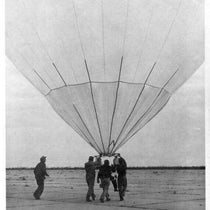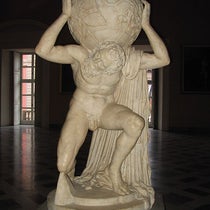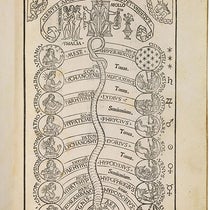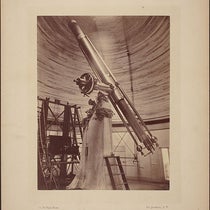Scientist of the Day - Grigory Razumovsky
Count Grigory Kirillovich Razumovsky, a Ukrainian nobleman and geologist, was born Nov. 10, 1759. Grigory was the son of a Ukrainian Cossack military commander with the title of "Hetman," who later became field marshal to the Russian Army, when Catherine the Great abolished the Hetman titles. Grigory had four older brothers, one of whom, Andrey, was an enthusiastic supporter of the arts in general, and of Ludwig von Beethoven in particular, whom he met in Vienna. Andrey commissioned a set of three string quartets from Beethoven, which were completed in 1806 and are known as the Razumovsky quartets (opus 59, nos. 1-3), the first of Beethoven's "middle quartets." Beethoven was appreciative enough to insert a Russian folk theme into the first two quartets. Beethoven subsequently dedicated his Fifth and Sixth Symphonies to Andrey.
But to get back to Grigory, he criticized the Tsar (Alexander I) for failing to stand up to the feudal nobles, and he was exiled from Russia, but he was welcomed into the nobility of Bohemia and allowed to keep his rank of Count. He remained in Europe for the rest of his life. I have not discovered the date of his exile, but it was probably after 1816, when he published in St. Petersburg the little book we are about to discuss.
Razumovsky was interested in all aspects of natural science, but especially in geology, and he was one of the first to catalog the "erratics" that dot the Russian and Scandinavian countryside. An erratic is a large boulder that sits in an environment that is geologically foreign to it, as a block of granite would be, resting on a limestone surface. There are thousands of erratics in Alpine regions and, as Razumovsky and others like Leopold von Buch discovered, scattered all over eastern and northern Eurasia as well. Many of these weighed thousands of tons, and it was hard to imagine how they were moved from their original locations, wherever those locations were. There are not many illustrations of erratics that are contemporaneous with Razumovsky’s book, so we show one from an 1830 work by Henry De la Beche (second image), another from a 1841 book by Jean de Charpentier (first image; see our post on Charpentier for more such illustrations), and a modern photo of an erratic in Estonia, close to Grigory’s stomping grounds, that might well be catalogued in Razumovsky’s book (third image).
The book Razumovsky published in 1816 was called: Coup d'oeil géognostique sur le Nord de l'Europe général et en Russie en particulier (A Geological Glance at Northern Europe in General and at Russia in Particular). In it, he compiled a list of all the known erratics of Russia, along with the nearest rock formations that contained that kind of rock. Many erratics by his reckoning must have travelled hundreds of miles, which for Razumovsky was evidence of a catastrophic flood (we would now attribute the wanderlust of erratics to glacial ice, not floods, but the glacial theory was 25 years in the future in 1816).
We do not own the Geological Glance. I have never seen a copy, and I only know about it because Martin Rudwick devoted several pages to Razumovsky’s book on erratics in his magisterial Worlds Before Adam (2008). I have to assume the 1816 book is not illustrated, because Rudwick did not reproduce any, and he really loved original geological images. As Rudwick noted, the title did not do Grigory any favors, since it is hard to tell from the title that this is a book about erratics. Grigory had it reprinted in Berlin in 1819, but he kept the same title, and the Berlin edition is equally scarce. I looked for a copy for many years when I was advising the Library on rare-book acquisitions, and never found a single one on the market.
Had more people known about Grigory’s book and his discoveries of northern erratics, it is possible that ideas of glacial transport might have arisen earlier than they actually did, which is to say, before 1840, when Louis Agassiz published his Études sur les glaciers. But who knows, perhaps more readers would just have meant more geologists convinced that raging floods were require to transport such massive blocks of stone.
As to how Razumovsky got interested in erratics, is it possible that Razumovsky was intrigued by the Thunder Stone in Saint Petersburg, which supports the statue of the Bronze Horseman, Peter the Great? The Thunder Stone was an 1800-ton granite erratic that came to rest eons ago north of St. Petersburg; in 1769-70, under orders from Catherine the Great, it was transported by rail six miles to the coast, and then brought the last 10 miles by barge to St. Peterburg Square, where it was put in place, waiting another 12 years for the statue to be cast and installed (fourth image). Did Razumovsky gaze upon the Thunder Stone as a young man and wonder, where in the world did it come from, how did it get there, and are there more like it?
The noted popular science writer Stephen Jay Gould once wrote an essay called “The Razumovsky Duet”, which was included in his collection Dinosaur in a Haystack (1995). Gould contrasted the willing patronage of Beethoven by Andrey Razumovsky with the refusal of another Razumovsky to assist when most of Moscow’s libraries were burned to the ground during Napoleon’s invasion of 1812. This other Razumovsky, however, was not Grigory, but a third brother, Alexei Kirillovich, who was apparently quite a waste of a human being. Grigory, the geologist, was not even mentioned in the essay, suggesting that Gould had never heard of him. That was too bad. Had he known, he could have expanded his essay to include Grigory and one other brother, or the father, and he could then have called his essay “The Razumovsky Quartet”, with a double meaning that doesn’t come along very often.
And although it is not relevant to Grigory and his erratics, I nevertheless scoured the web, looking for a suitable video recording of one of the Razumovksy quartets, and I think I found one, a stirring yet elegant performance by the Dover Quartet of Beethoven’s String Quartet no. 8 in E minor, the 2nd Razumovsky quartet, a performance that won the gold medal at the Banff International String Quartet Competition in 2013. The nod to Andrey Razumovsky begins with the “Theme Russe”, introduced by the viola at the 25:53 mark and passed from instrument to instrument for several minutes. It's not Mussorgsky, but it is lovely.
There is a portrait of Grigory on Wikipedia, but it is such a poor one, and undocumented, that I prefer to have him go faceless here. As well-known as he was in Europe, there must be a better portrait of Count Grigory in some castle, waiting to be discovered.
William B. Ashworth, Jr., Consultant for the History of Science, Linda Hall Library and Associate Professor emeritus, Department of History, University of Missouri-Kansas City. Comments or corrections are welcome; please direct to ashworthw@umkc.edu.










